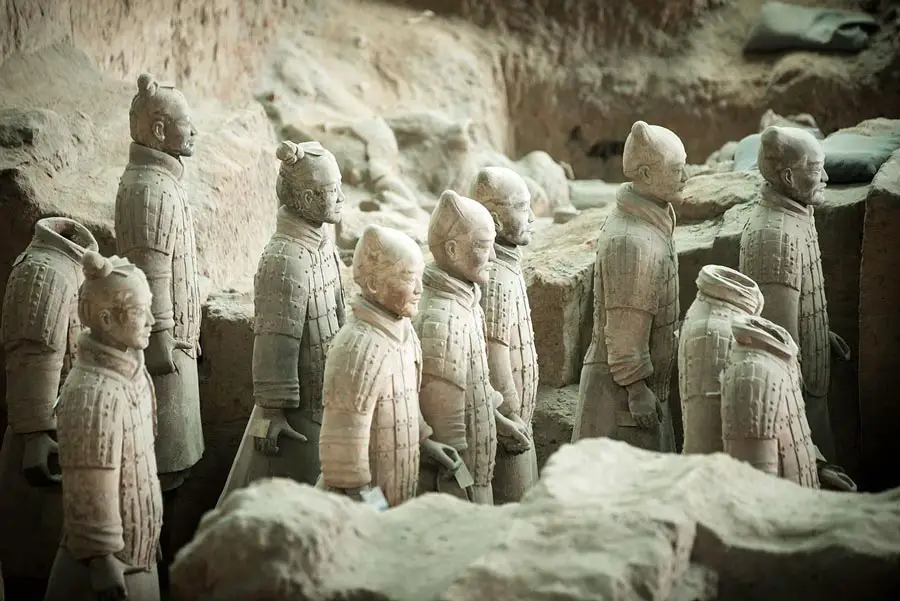In the heart of China, shrouded in the Lintong district of Xi’an (Shaanxi), lies a monument to an ancient dynasty — the tomb of Qin Shi Huang, the first emperor of China. While the world marvels at the famed Terracotta Army that guards this mausoleum, archaeologists have hesitated to unlock the secrets held within. The fear is not just of disturbing the emperor’s eternal rest but of navigating a treacherous terrain of traps meticulously designed to thwart any intruders. This article delves into the mystique surrounding the tomb, the legends that have endured through the centuries, and the challenges archaeologists face in unraveling this enigma.
II. The Mausoleum and Its Guardian Army
Constructed over 2,200 years ago, Qin Shi Huang’s mausoleum stands as a testament to ancient Chinese architectural prowess. The emperor’s vision for the afterlife was grand, adorned with palaces, scenic towers, and a magnificent array of rare artifacts. However, the most renowned guardians of his tomb are the life-size terracotta warriors of Xi’an. These intricately crafted soldiers were meant to accompany the emperor in death, a testament to the emperor’s obsession with immortality and an army to protect him in the afterlife.
III. The Legend of Traps
The reluctance to open the emperor’s tomb is rooted in a legend that echoes through time. Sima Qian, an ancient Chinese historian, penned an account a century after Qin Shi Huang’s death, detailing the existence of elaborate traps concealed within the mausoleum. These traps, as described by Sima Qian, include crossbows and arrows strategically positioned to automatically engage any intruder. Additionally, a complex system of mercury rivers, mimicking natural water channels, was said to flow mechanically within the tomb.
IV. The Fear of Disturbing History
While modern archaeological techniques have advanced, allowing for precise examinations of ancient remains, the tomb of Qin Shi Huang poses a unique challenge. The fear is not merely of damaging the physical structure but of losing invaluable historical information that might be irreparably compromised during excavation. This delicate balance between exploration and preservation has led to a cautious approach, leaving the tomb untouched despite technological capabilities that could reveal its secrets.
V. Mercury and the Emperor’s Obsession
The legend gains credibility from historical facts surrounding Emperor Qin Shi Huang’s obsession with mercury. Known for drinking mercury due to his belief in its purported health benefits, it is speculated that this habit might have contributed to his premature death at the age of 49. The same mercury that flowed through his veins, mirroring the rivers in his tomb, is believed to be present in anomalous concentrations around the burial site. This lends credence to Sima Qian’s account and suggests that the tomb has remained sealed and unlooted throughout the centuries.
VI. The Historical Context
Qin Shi Huang, who reigned from 221 to 210 BC, was a pivotal figure in Chinese history. He not only unified the warring states but also laid the foundation for a centralized imperial system. His mausoleum reflects not only his achievements in life but also his intricate planning for the afterlife. The elaborate traps, if true, exemplify the emperor’s desire to safeguard his treasures and ensure that he faced no disturbances in the world beyond.
VII. The Ongoing Mystique
The tomb of Qin Shi Huang remains an ongoing mystery, a conundrum that challenges the archaeological community. The potential risks associated with excavation, coupled with the historical reverence for the emperor’s resting place, have led to a cautious approach. As technology advances and new methods emerge, the tantalizing prospect of unraveling the secrets of the tomb becomes even more compelling.
VIII. Conclusion: Balancing Curiosity and Caution
In the heart of China, beneath the silent hills of Lintong, lies a mausoleum that holds not only the mortal remains of an ancient emperor but also the echoes of a bygone era. The reluctance to open Qin Shi Huang’s tomb is not just a nod to historical caution but a testament to the delicate dance between curiosity and preservation. As we stand on the cusp of technological breakthroughs, the allure of unlocking the secrets of China’s first emperor beckons, yet the fear of disturbing a carefully preserved history lingers, challenging us to find a delicate balance.

